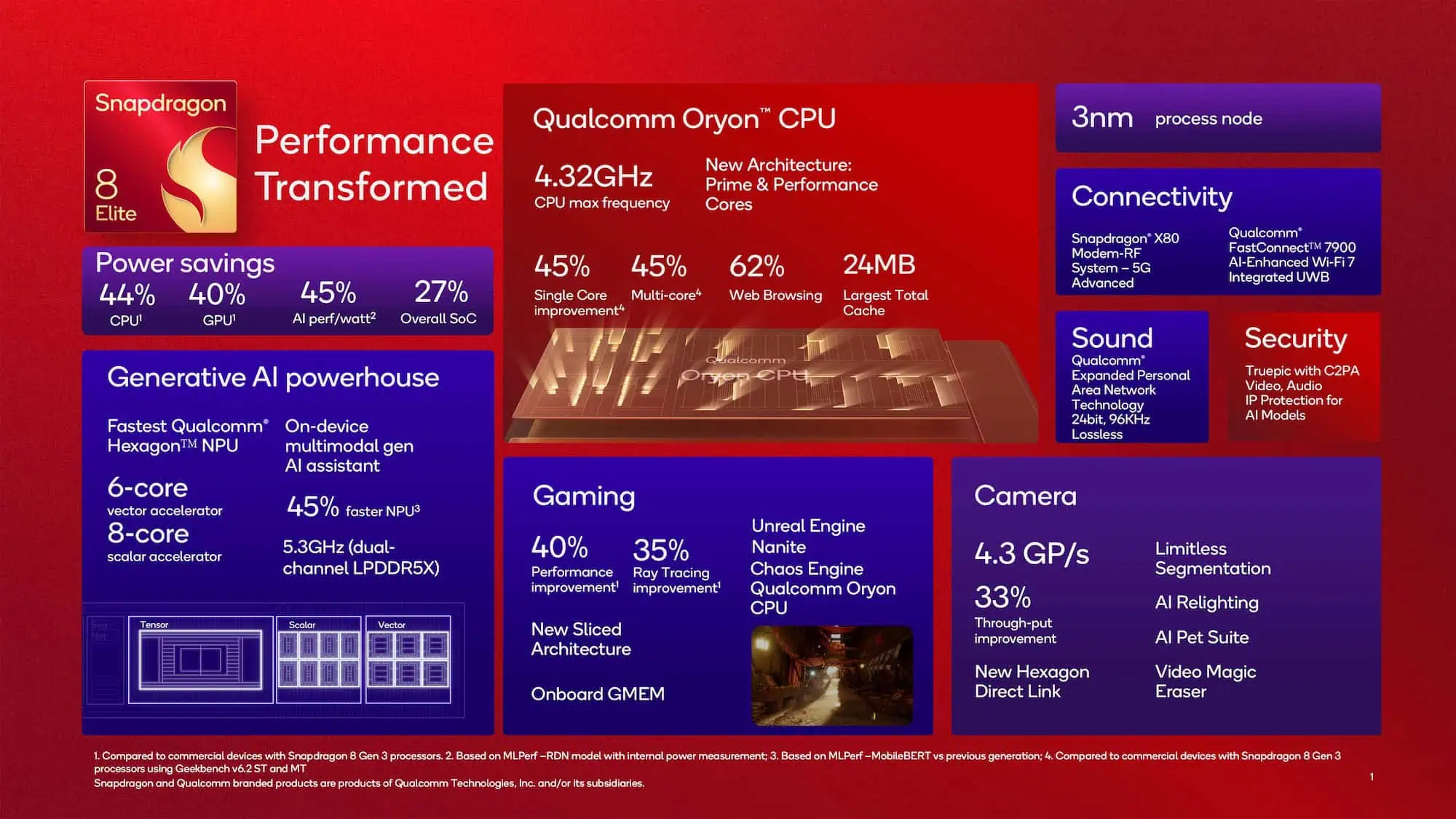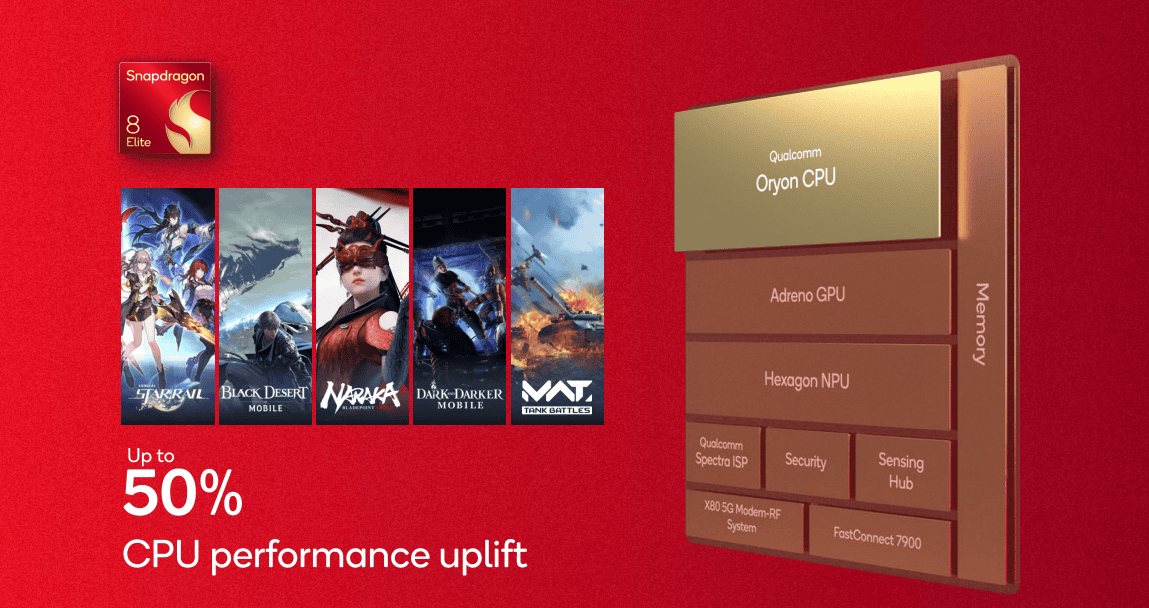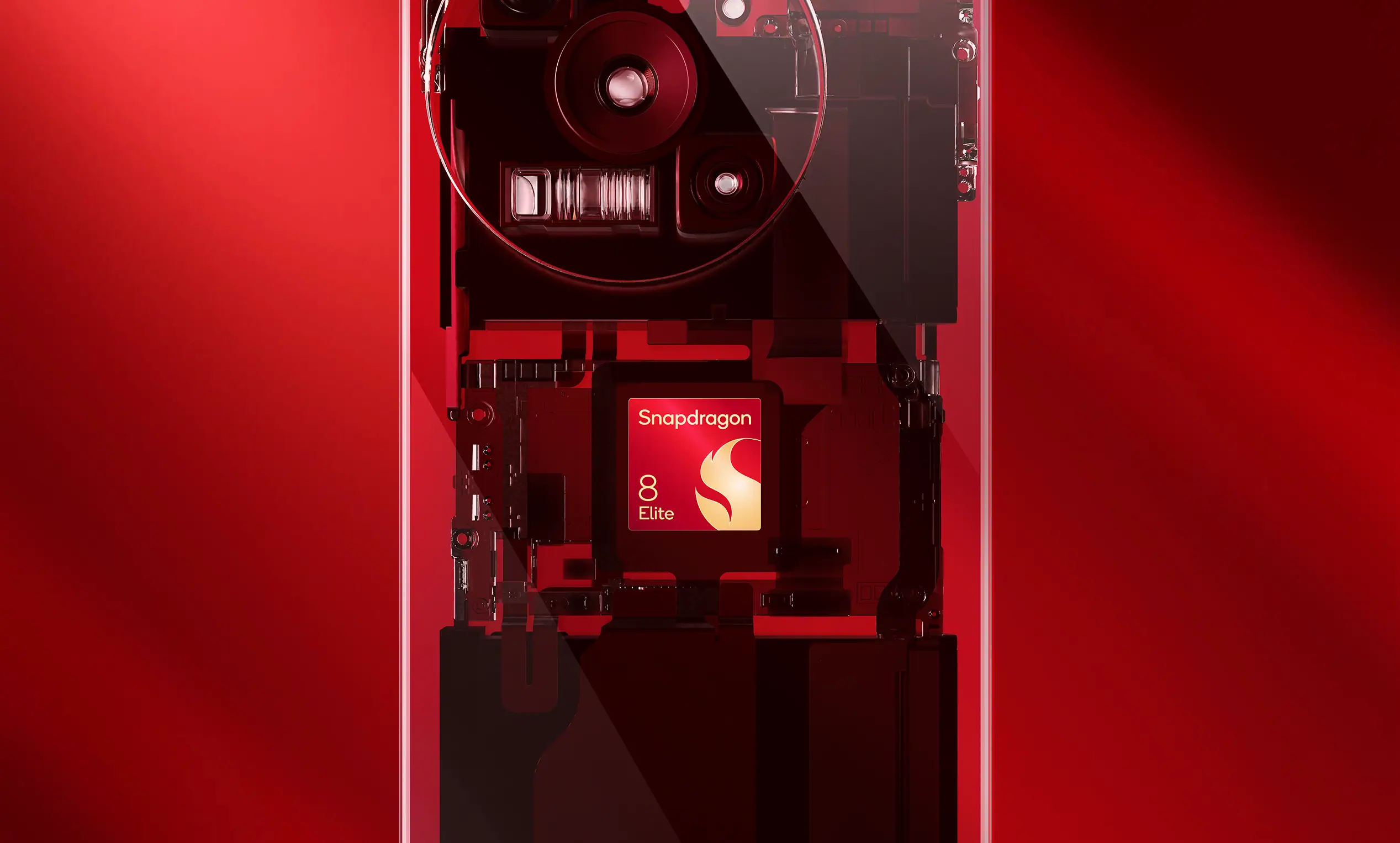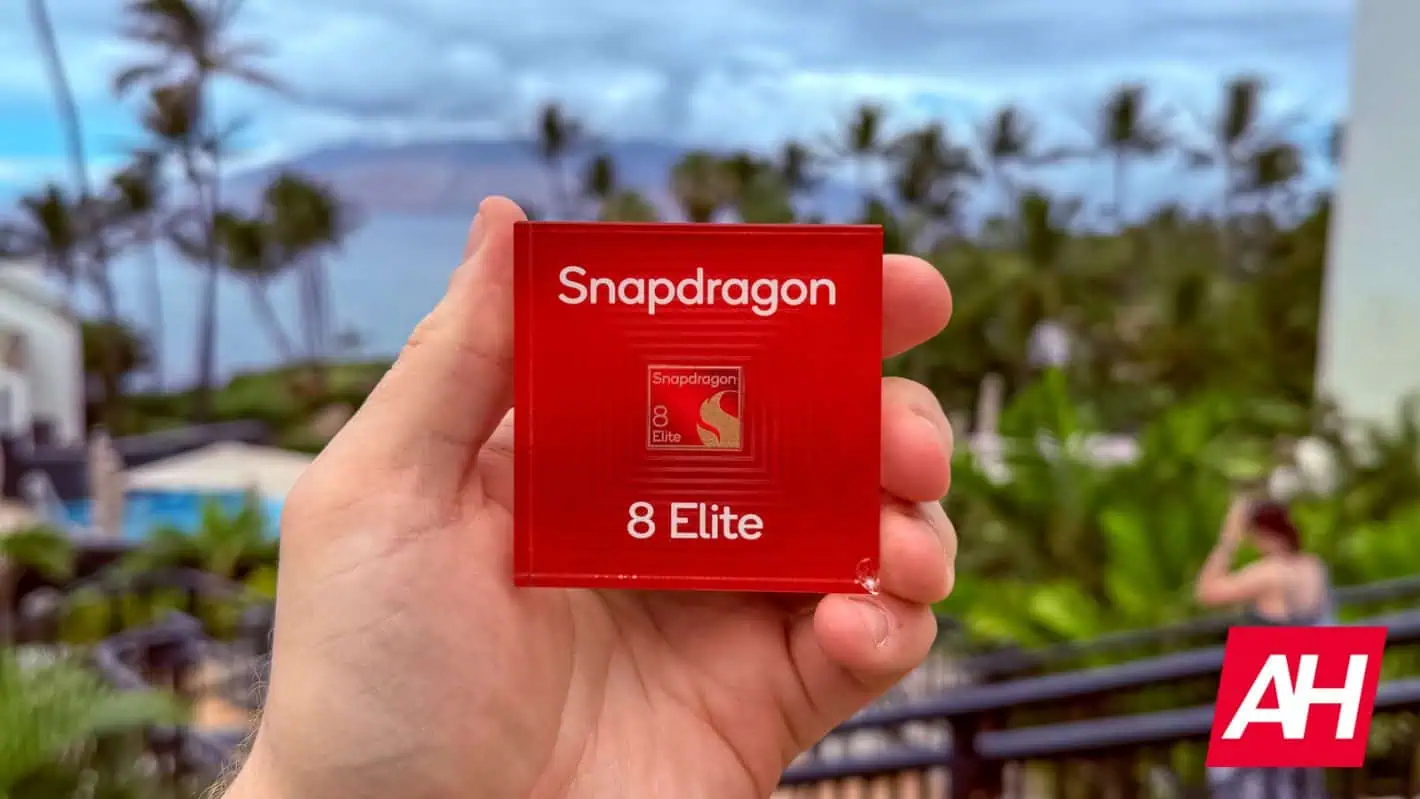On October 21, 2024, Qualcomm announced the Snapdragon 8 Elite chipset. This is now the company’s flagship silicon, and it also gets a new name. It now uses the “Elite” name that Qualcomm is also using on its PC chipsets, such as the Snapdragon X Elite. The reason for this name change is that Qualcomm uses the term “Elite” for its most advanced products.
With the advances that Qualcomm was able to make with Snapdragon 8 Elite, it makes sense for them to change up the name this year. Qualcomm is using all-new second-generation Oryon CPU cores, which were built from the ground up for mobile. This allows the Prime cores to reach a record 4.32GHz clock speed. That makes this the fastest mobile processor on the planet, at least for now. The Snapdragon 8 Gen 3, its predecessor, had a max clock speed of 3.3GHz. Its primary competitor was just announced, the MediaTek Dimensity 9400, which has a max clock speed of 3.6GHz. So, this is a massive advancement for Qualcomm for 2025.
Qualcomm moved over to a 3nm process for the Snapdragon 8 Elite this year versus using 4nm last year. This will result in some pretty massive gains in basically everything: Performance, graphics, and power savings. Here’s everything you need to know about the brand-new Snapdragon 8 Elite chipset.
Qualcomm Snapdragon 8 Elite Specs
The main spec that you should care about with the Snapdragon 8 Elite, is each core. So, with the Snapdragon 8 Elite there are two Prime cores which are clocked at up to 4.32GHz and six performance cores that are clocked at up to 3.53GHz. There’s no efficiency cores this year. Over the years, Qualcomm has steadily been removing efficiency cores, and now they are no longer needed, thanks to the advancements in the second-generation Oryon CPU.
To help with efficiency, Qualcomm has also included a 12MB L2 Cache for each CPU cluster, bringing the cache up to 24MB. It also supports the most advanced LPDDR5 memory, at up to 24GB. Qualcomm says that this is going to support the most advanced generative AI tasks that their customers want to do.

When it comes to performance improvements, this means a 45% CPU improvement over the Snapdragon 8 Gen 3. That’s also a 40% improvement on the GPU and 45% on the AI performance per watt. Additionally, on the gaming side, there’s a 40% performance improvement and 35% ray tracing improvement with support for Unreal Engine 5 Nanite and Chaos Physics.
On the AI side, Qualcomm quotes that the NPU is about 45% faster, again compared to the Snapdragon 8 Gen 3. That makes it the fastest hexagon NPU. This is all done using a 3nm process using TSMC’s latest N3E process.
Qualcomm says that the Snapdragon 8 Elite supports the largest global Gen AI model ecosystem and supports longer token inputs. So you can provide your AI assistant with an entire book chapter or lengthy technical document to make it an expert.
New Snapdragon X80 5G Modem
Inside the Snapdragon 8 Elite is the latest 5G modem from Qualcomm – Snapdragon X80. This was announced back at MWC Barcelona in February. And now it is being put into a chipset. This modem is 5G Advanced-ready and supports all of the other 5G standards, including mmWave, Sub-6 GHz, 5G Standalone and Non-Standalone modes, standalone mmWave and mmWave-Sub-6 dual connectivity.
Theoretically, this modem can support downlink up to 10Gbps and uplink up to 3.5Gbps. And it supports 3GPP Release 17 and Release 18. Those are the latest releases from the 3GPP, so you’re going to get some pretty good connectivity with this modem.

2nd Gen Oryon CPU
Perhaps the biggest advancement with Snapdragon 8 Elite is, the brand new Oryon CPU Cores. All eight cores in this chipset have been rebuilt from the ground up, for mobile. So these are not the same Oryon CPU cores brought over from Snapdragon X Elite.
This next generation of Oryon is able to deliver power, speed, and efficiency. Qualcomm is touting a 45% boost in CPU performance and 45% improved power efficiency. Qualcomm is also quoting that gaming time can be extended by two and a half hours, thanks to a 27% overall power savings.
Along with the rebuilt Oryon CPU cores, Qualcomm also has the largest shared cache, which delivers insanely fast data retrieval. And it also has the fastest clock speed in the world, for mobile at 4.32GHz.
Camera Improvements
It’s important to remember that the cameras that phone companies put onto their devices are actually limited by what the processor can handle. So Qualcomm does have some pretty incredible numbers for this processor, but these are the maximum megapixels that the Snapdragon 8 Elite can handle.
Now, with Snapdragon 8 Elite, we’re looking at up to 320-megapixel photo capture, up to 48-megapixel triple camera at 30FPS with Zero Shutter Lag, and up to 108-megapixel single camera at 30FPS with Zero Shutter Lag. And this is all with HDR being enabled.
On the recording side of things, Qualcomm has added support for the latest HDR, DCG+VS, Staggered, QDOL, Less Blanking and Multiframe HDR image sensors. There’s also support for Rec. 2020 color gamut in photo and video capture, as well as up to 10-bit color depth in both photo and video capture. Qualcomm is also supporting Google Ultra HDR photo capture, and you can now capture HDR video in HDR10+, HDR10, HLG and Dolby Vision.
Snapdragon 8 Elite will also support 8K HDR resolution video playback at up to 60 FPS. There’s also 4K video capture at 120FPS, and slow-mo video capture at 1080p at 480 FPS.
There are quite a few additions to the camera setup this year with Snapdragon 8 Elite, and it also includes AI-based face detection and AI for 3A (auto-focus, auto-exposure, and auto-white balance). Though, we will have to wait and see how OEMs will use these new features that are available at the processor level.
Multimodal Gen AI
Whether you like it or not, Generative AI is coming and coming to every smartphone on the market. We’ve already seen it on quite a few smartphones in 2024, with the Snapdragon 8 Elite it’s going to get even better.
Thanks to the Qualcomm AI Engine with multimodal Gen AI, you’re going to be able to create just about anything faster than ever before. The AI Engine is powered by various AI models, including large multimodal models (or LMMs), as well as LLMs and LVMs. It supports the largest global Gen AI model ecosystem and longer token inputs.
The Qualcomm Sensing Hub is able to understand personal context, which allows your multimodal generative AI assistant to make suggestions and decisions that suit you best.
Of course, all of this is helped significantly by the 45% faster Qualcomm Hexagon NPU, and 45% improved performance per watt that pushes AI to new heights.

Snapdragon 8 Elite Benchmarks
At Snapdragon Summit, we were able to benchmark the Snapdragon 8 Elite on what is called a reference device. It’s basically a device that shows how good the processor is; the unit we were able to test with had a 6.8-inch WFHD+ 144Hz AMOLED display, the Snapdragon 8 Elite, 24GB of LPDDR5x RAM that was clocked at 4.8Gbps, 1TB of UFS 4.0 storage, and a pretty tiny 4,167mAh battery. Of course, the point of a reference device is to show off the SoC, not the battery life, so that small battery isn’t surprising.
On the Snapdragon 8 Elite, we ran the usual benchmarks we do in reviews. This way, we could compare the scores versus those of other phones we’ve reviewed recently. Geekbench 6 scored 3,220 in the single-core, 10,415 in the multi-core and 17,867 in the GPU test. That beats the Snapdragon 8 Gen 3 quite handily, and of course, the Tensor G4. It also beats Apple’s A18 Pro chipset, but Apple’s graphics are still on another level.
For AnTuTu, it also broke that 3 million mark. Scoring 3,035,115. At the same time, most other chipsets were under 2 million. The Xiaomi 14 Ultra scored 1,771,035, the Pixel 9 Pro XL scored 1,187,754, and the iPhone 16 Pro scored 1,657,579.
Snapdragon 8 Elite-powered Smartphones
Even though Qualcomm announced the Snapdragon 8 Elite back in October, we’ve already seen a ton of devices launch with this chipset. Here’s what has been announced already.
- Xiaomi 15
- realme GT 7 Pro
- Nubia Z70 Ultra
- Redmagic 10 Pro Plus
- OnePlus 13
- iQOO 13
- ASUS ROG Phone 9
- HONOR Magic 7
- HONOR Magic 7 Pro
- HONOR Magic 7 RSR (Porsche Design)
Samsung and Qualcomm worked together for the “Snapdragon 8 Elite for Galaxy” version this year, making it more efficient than the regular Snapdragon 8 Elite. It’s available on the entire Galaxy S25 series worldwide (no Exynos version this year), and in our early testing, it does appear to be far more efficient than other Snapdragon 8 Elite handsets, even with a smaller battery.


